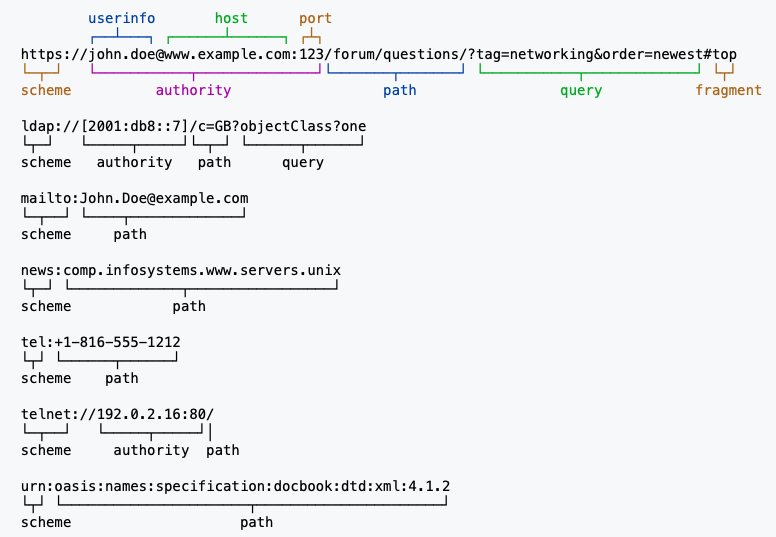2.2. HTTP Identifier
URN - name (i.e. book title)
URI - resource (i.e. one particular unit of book with that title)
URL - location (i.e. where to get it)
Locators are also identifiers, so every URL is also a URI
There are URIs which are not URLs
Examples:
Mark Watney
This is the name, which is an identifier. It is like a URI, but cannot be a URL, as it tells you nothing about the location or how to contact Mark. In this case it also happens to identify at least several other people in the USA alone. [4]
Johnson Space Center Home, 1601 NASA Parkway, Houston, TX 77058-3145
This is a locator, which is an identifier for that physical location. It is like both a URL and URI (since all URLs are URIs), and also identifies me indirectly as "resident of..". That would uniquely identify Marks location, if he was alone in that place. There is a lot of employees at JSC. Although habitat on Mars could be URI an URL. [4]
I say "like" because these examples do not follow the required syntax.
2.2.1. URI
URI - Uniform Resource Identifier
URI - resource (i.e. one particular unit of book with that title)
Example:
https://example.com/path/resource.txt#fragmentExample:
//example.com/path/resource.txtExample:
/path/resource.txtExample:
path/resource.txtExample:
../resource.txtExample:
./resource.txtExample:
resource.txtExample:
#fragment
A Uniform Resource Identifier (URI) is a unique sequence of characters that identifies a logical or physical resource used by web technologies.
URIs may be used to identify anything, including real-world objects, such as people and places, concepts, or information resources such as web pages and books. Some URIs provide a means of locating and retrieving information resources on a network (either on the Internet or on another private network, such as a computer filesystem or an Intranet), these are Uniform Resource Locators (URLs). Other URIs provide only a unique name, without a means of locating or retrieving the resource or information about it, these are Uniform Resource Names (URNs). The web technologies that use URIs are not limited to web browsers. URIs are used to identify anything described using the Resource Description Framework (RDF), for example, concepts that are part of an ontology defined using the Web Ontology Language (OWL), and people who are described using the Friend of a Friend vocabulary would each have an individual URI. [3]
Example:
https://example.com/path/resource.txt#fragment
//example.com/path/resource.txt
/path/resource.txt
path/resource.txt
../resource.txt
./resource.txt
resource.txt
#fragment

2.2.2. URN
URN - Uniform Resource Name
URN - name (i.e. book title)
It says what is it, but not where to get it
Example:
urn:isbn:9788395718625- Python - from None to AI book, identified by its book number.Example:
urn:ISSN:0167-6423- The scientific journal Science of Computer Programming, identified by its serial number.Example:
urn:uuid:6e8bc430-9c3a-11d9-9669-0800200c9a66- A version 1 UUID.
A Uniform Resource Name (URN) is a Uniform Resource Identifier (URI) that uses the urn scheme.
URNs are globally unique persistent identifiers assigned within defined namespaces so they will be available for a long period of time, even after the resource which they identify ceases to exist or becomes unavailable. URNs cannot be used to directly locate an item and need not be resolvable, as they are simply templates that another parser may use to find an item [2].
Examples:
urn:isbn:9788395718625- Python - from None to AI book, identified by its book number.
urn:ISSN:0167-6423- The scientific journal Science of Computer Programming, identified by its serial number.
urn:uuid:6e8bc430-9c3a-11d9-9669-0800200c9a66- A version 1 UUID.
It says what is it, but not where to get it.
2.2.3. URL
URL - Uniform Resource Locator
URL - location (i.e. where to get it)
Example:
https://john.doe@www.example.com:123/forum/questions/?tag=networking&order=newest#topExample:
ldap://[2001:db8::7]/c=GB?objectClass?oneExample:
mailto:John.Doe@example.comExample:
news:comp.infosystems.www.servers.unixExample:
tel:+1-816-555-1212Example:
telnet://192.0.2.16:80/Example:
urn:oasis:names:specification:docbook:dtd:xml:4.1.2
A Uniform Resource Locator (URL), colloquially termed a web address, is a reference to a web resource that specifies its location on a computer network and a mechanism for retrieving it. A URL is a specific type of Uniform Resource Identifier (URI), although many people use the two terms interchangeably. URLs occur most commonly to reference web pages (http), but are also used for file transfer (ftp), email (mailto), database access (JDBC), and many other applications. Most web browsers display the URL of a web page above the page in an address bar. A typical URL could have the form http://www.example.com/index.html, which indicates a protocol (http), a hostname (www.example.com), and a file name (index.html). [1]
Example:
https://john.doe@www.example.com:123/forum/questions/?tag=networking&order=newest#top
ldap://[2001:db8::7]/c=GB?objectClass?one
mailto:John.Doe@example.com
news:comp.infosystems.www.servers.unix
tel:+1-816-555-1212
telnet://192.0.2.16:80/
urn:oasis:names:specification:docbook:dtd:xml:4.1.2
